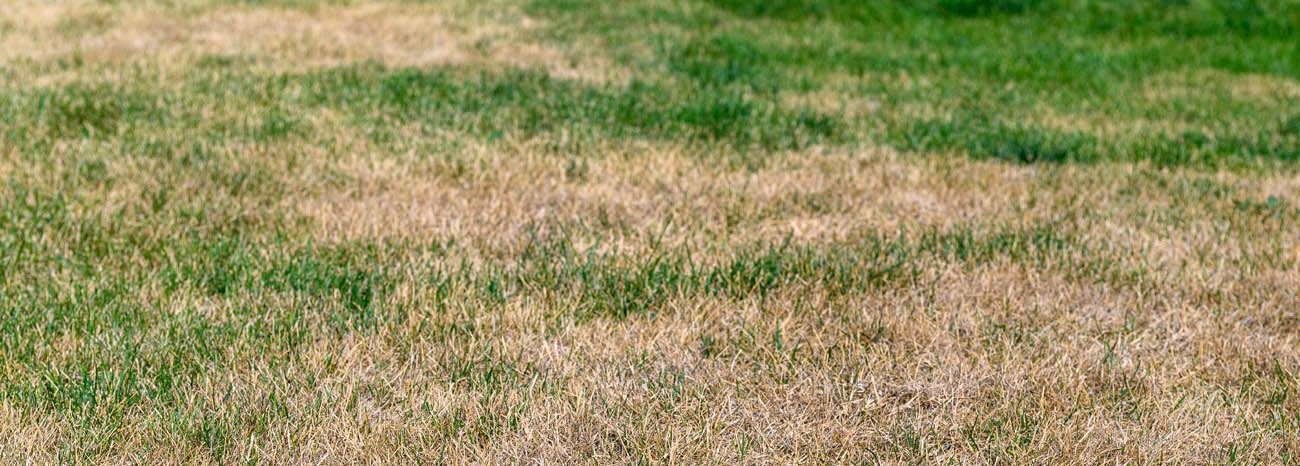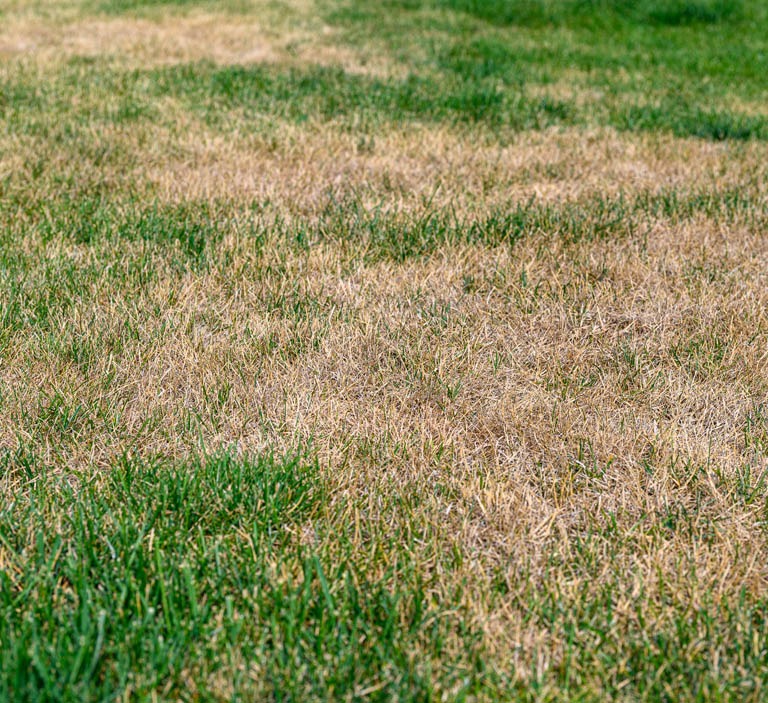Summer can be a tough time for lawns, especially when intense heat, lack of rainfall, and increased foot traffic take their toll. One of the most common signs that your lawn is suffering is the appearance of brown patches. If you’ve noticed that your lush, green lawn is turning brown, you’re not alone. The good news is there are ways to bring your lawn back to life. Understanding the causes of a browning lawn and how to fix it will help you restore your lawn’s vibrancy and keep it healthy through the hottest months of the year.
Understanding the Causes of Browning Grass
Several factors can contribute to your lawn turning brown and identifying the root cause is the first step in fixing the problem. From watering issues, nutrient deficiencies, pests, and diseases to environmental stress, addressing these issues promptly is essential to prevent further damage and restore your lawn.
Watering Issues
The Problem:
Watering problems are one of the leading causes of brown grass. Both overwatering and underwatering can lead to lawn stress and browning.
- Overwatering: When a lawn receives too much water, it can drown the roots. This leads to poor nutrient absorption and creates a welcome environment for fungal growth. Overwatered lawns often have a spongy feel and may develop thatch or moss.
- Underwatering: On the flip side, insufficient water during the scorching summer months can cause your grass to go dormant. Brown spots may appear, indicating that the grass is struggling to survive with limited moisture.
The Solution:
Adjust Your Watering Practices
Adjust your watering schedule to provide about 1 to 1.5 inches of water per week, delivered in deep, infrequent sessions. This amount includes rainfall. Doing this encourages the roots to grow deeper, making your lawn more drought-resistant.
Check soil moisture levels by inserting a screwdriver into the ground. If it’s difficult to push in, your lawn likely needs more water. Your soil should be moist at least 6 inches deep.
Optimize Your Sprinkler Systems: Make sure your sprinkler heads are adjusted to water evenly across your lawn. Check for clogged or misaligned heads regularly.
Nutrient Deficiencies
The Problem:
A lack of essential nutrients can cause your lawn to turn brown and patchy. Nutrient deficiencies can result in grass weakened to the point that it can’t withstand environmental stress.
Yellowing grass is often a sign of nitrogen deficiency, while browning can indicate a lack of other nutrients such as potassium, iron, or other vital nutrients.
The Solution:
Soil Testing & Fertilization
Conduct a soil test to determine your lawn’s specific nutrient needs and what it may be lacking. Soil testing kits are available at most garden centers or you may want to learn more about our Enhanced Soil Test. Created by our research and development team, this comprehensive test provides detailed information about your soil enabling us to achieve the right balance of nutrients, pH level, and organic elements to grow that beautiful lawn.
A soil test will reveal your soil’s pH and nutrient levels. Once you have the results, apply the appropriate fertilizer. A balanced fertilizer with a slow-release formula is often a good choice. Apply fertilizer evenly across your lawn. Water the lawn thoroughly after fertilization to help the nutrients penetrate the soil.
Pests and Diseases
The Problem:
Pests and diseases are another common cause of browning lawns. Grubs, chinch bugs, and other pests feed on grass roots, while diseases like brown patch or rust can spread quickly in hot, humid conditions.
The Solution:
If pests or diseases are causing brown spots in your lawn, prompt treatment is necessary to prevent further damage.
Identifying & Managing Pests
Look for signs of pests by checking the soil beneath affected areas. Grubs, for example, are small, white, C-shaped larvae that feed on grass roots, leading to dead patches. Chinch bugs suck the sap from grass blades, causing the blades to brown and die.
Apply a grub control product or insecticide as soon as you notice signs of infestation.
Recognizing & Treating Diseases
Lawn diseases can spread quickly, so early detection and treatment are crucial. Fungicides can be an effective treatment, but prevention is key. Proper watering, mowing, and fertilization practices can reduce the risk of disease. Ensure your lawn has good air circulation, and adequate drainage and is not overwatered.
Environmental Stress
The Problem:
Extreme weather conditions, such as heat and drought, can cause your lawn to turn brown. While some grasses, particularly cool-season varieties, are more susceptible to drought stress, all lawns can suffer during extreme weather.
Additionally, consistent foot traffic in certain areas can compact the soil, preventing water and nutrients from reaching the roots, and leading to brown spots.
The Solution:
Combat lawn stress caused by extreme heat and drought conditions by watering your lawn deeply and less frequently. Consider installing a drip irrigation system to ensure even watering. If your area is experiencing a drought, reduce foot traffic on the lawn and avoid mowing during the hottest part of the day.
Annual lawn aeration is the best way to alleviate the impact of soil compaction from foot traffic. The aeration process involves removing small plugs of soil to improve air, water, and nutrient penetration.
Repairing Lawn Damage
Once you’ve identified and addressed the underlying causes of your lawn’s browning, it’s time to repair the damage to restore your lawn’s vitality and beauty.
Reseed or Sod Brown Patches
If certain areas of your lawn are dead or severely damaged, you may need to reseed or lay new sod. Reseed thin or bare patches, and consider sodding for larger areas.
- Reseeding: Choose grass seeds that match your existing lawn. Loosen the soil in the affected areas, spread the seeds evenly, and lightly rake them in. Keep the area moist until the new grass is well established.
- Sodding: For larger dead patches, sod may be a quicker solution. Cut out the dead grass, lay the sod, and water it thoroughly. Be sure to tamp down the sod to eliminate air pockets.
Adjust Your Lawn Care Routine
Prevent future browning by maintaining a consistent lawn care routine tailored to the needs of your grass type and local climate.
- Mowing: Mow your lawn regularly, but avoid cutting more than one-third of the grass blade at a time. The recommended lawn height for most lawns is around 3 inches.
- Aeration and Dethatching: Aerate your lawn in the spring or fall to prevent soil compaction. Dethatch if you notice a thick layer of organic material preventing water and nutrients from reaching the roots.
- Fertilization: Follow a regular fertilization schedule based on your soil test results. A balanced approach will keep your lawn healthy and resilient.
Know When to Call in the Professionals
While many of these lawn care tasks can be handled by homeowners, severe browning or persistent issues may require professional help. Our lawn care experts can diagnose complex problems and apply treatments more effectively than DIY methods, saving you time and money in the long run. To learn more about how we can help, contact us by filling out the form below or call 215.799.2016.

